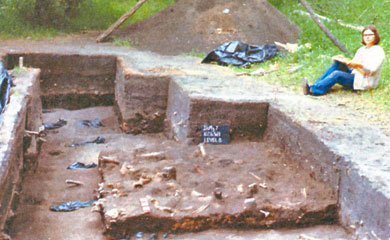Site Development
• requires consultation with CDN regarding treatment of
the site,
whether it should be interpreted, if so what messages should be
interpreted and how it can be promoted respectfully
• provides an opportunity to present the First Nations rich spiritual
traditions of creČation, sacredness and respect (Cutschall 1998;
Laviolette 1991; Elias 1988)
• requires consultation with Parks Canada on how the site should
be managed and what interpretive signage should be displayed, subject
to CDN approval
• access is readily available along the nearby road allowance
Non-Visible Sites
• have no obvious surface manifestations but can be the locations
of important past activities
• a visitor's experience is negligible when visiting a field with
no evidence of the ancient, important events
• to provide a meaningful experience, on-site signage is crucial
• below is a selection of sites with significant stories from among the
very many that could be developed
A. Brockinton Bison Kill and Camp Site
• located on the NE 'A 10-3-2-27 Wl, on the
floodplain of the
Souris River below the Percy
Brockinton homestead
• consists of a stratified site that Syms excavated
in 1970 and
1971 with a major bison kill overlain
by a Duck Bay Culture camp,
circa. AD 1000-1350,
and a Plains, Williams Culture camp,
circa. AD
1350-1500 (Syms 1971, 1977;
Whelan 1976)
• bone bed from bison pound visible along river bank
|

Bone bed of the Brockinton Site being
excavated
in 1971.
|
|



